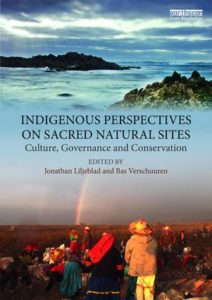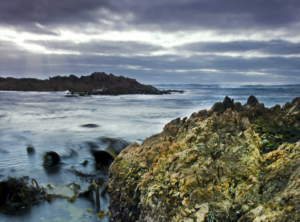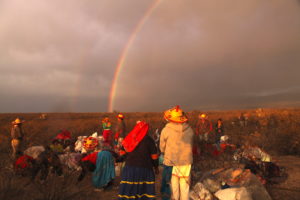
Seo an tAirteagal atá le feiceáil ar an Nuachtlitir Nuachtlitir Taighde ar Láithreáin Naofa Márta 2019 Eisiúint.
le Jonathan Liljeblad
Ardú na gCeart Dúchasach
Ag tosú sa dara cuid den 20ú haois agus ag leanúint ar aghaidh isteach sa 21 st , bhailigh iarracht dhomhanda móiminteam trí bhealaí éagsúla chun coincheap na gceart Dúchasach a aithint agus aghaidh a thabhairt air. Tá pobail dhúchasacha i láthair ar fud an domhain agus bhí siad ann roimh chóras domhanda reatha na náisiún-stáit. Lean gach náisiún-stáit a chur chuige féin i leith cultúir Dúchasacha, éagsúil i méid idir ghníomhartha a chuimsíonn speictream ó athmhuintearas agus de réir imeallú agus díothú iomlán. An t-údarás trína ndéileálann náisiúin stáit le Dúchasaigh
tá pobail ceangailte le stair impireachtaí Eorpacha atá sna 1648 Chruthaigh Peace Westphalia domhanda
córas bunaithe ar náisiúin a bhfuil ceannas acu, ina bhfuil smacht eisiach ag náisiún-stáit
daonra ar fad, críoch, agus acmhainní laistigh dá theorainneacha.
D'fhreastail tosaíocht choincheapúil na flaitheas náisiúnta ar shibhialtachtaí dúchasacha ón
Ordú domhanda agus iad a fholmhú le cumhacht neamh-dhúchasach, ar dtús ó riarachán coilíneach agus ansin
Rialtais Náisiúnta níos déanaí. Le cúpla bliain anuas, áfach, D'óstáil sé raon gluaiseachtaí le creimeadh
Stádas na flaitheas náisiúin. Tá creimeadh den sórt sin tagtha ón dá cheann thuas, I gciall a
Fás atá ag dul i méid i líon na n -institiúidí idirnáisiúnta agus na gconarthaí idirnáisiúnta a thug
náisiúin na náisiún laistigh de na rialacha maidir le raon de chórais idirnáisiúnta atá ag leathnú a chlúdaíonn a lán saincheisteanna
réimsí, agus ó thíos, Sa mhéid go bhfuil gluaiseachtaí sóisialta neamh-stáit agus líonraí sóisialta ag feidhmiú
Trasnú chun cúiseanna áirithe a chur chun cinn i gcoinne náisiún-stáit. I measc na réimsí agus na gcúiseanna eisiúna
tá sé ina ábhar do dhaoine dúchasacha.
Tá cuid mhaith den aird idirnáisiúnta ar dhaoine dúchasacha dírithe ar cheist na gcearta dúchasacha. Nóta ar leith bhí obair na Náisiún Aontaithe (A) institiúidí ar nós na gcearta daonna
Comhdháil (HAD), Oifig an Ard -Choimisinéir um Chearta an Duine (OHChR), agus an grúpa oibre ar dhaonraí dúchasacha (WGIP). Mar thoradh ar a n -iarrachtaí cruthaíodh Fóram Buan na Náisiún Aontaithe ar
Saincheisteanna Dúchasacha (Pfia) agus cearta dúchasacha a chur in iúl sa dlí idirnáisiúnta, An dá rud atá ann cheana
Conarthaí um Chearta an Duine cosúil leis an gCúnant Idirnáisiúnta ar Eacnamaíocht, Sóisialta, agus cearta cultúrtha (ICESCR)
nó ionstraimí cearta dúchasacha tiomnaithe mar an Eagraíocht Saothair Idirnáisiúnta (Il) Coinbhinsiún
Maidir le pobail dhúchasacha agus treibhe (Níl. 169) nó Dearbhú na Náisiún Aontaithe ar Chearta Dúchasacha
Daoine (Drip). I gcomhthráth le hiarrachtaí leathana domhanda den sórt sin tá níos mó gníomhaíochtaí saincheisteanna mar shaincheisteanna mar
Córas Oidhreachta Domhanda, a gcomhlachtaí comhairleacha - an tIonad Idirnáisiúnta um Staidéar ar Chaomhnú
agus maoin chultúrtha a athchóiriú (ICCROM), An Chomhairle Idirnáisiúnta ar Séadchomharthaí agus Láithreáin
(Iomos), agus an tAontas Idirnáisiúnta um Chaomhnú an Dúlra (IUCN)—An treoirlínte eisithe chuig
Cearta dúchasacha a chur chun cinn agus a fheidhmiú ar oidhreacht chultúrtha agus nádúrtha.
Saincheisteanna féideartha i gcearta dúchasacha
Tá an -chuid den obair do chearta dúchasacha á dtiomáint ag fonn chun oidhreacht na ndíobhálacha a rinneadh san am atá thart a réiteach le sibhialtachtaí dúchasacha faoin gcóras Westphalian. Agus inmholta, níl sé fós neamhleor. Más é an cuspóir ulterior réiteach ar an am atá thart, ansin ní leor córas bunaithe ar chearta a chur i bhfeidhm. Taobh amuigh de theorainneacha chóras bunaithe ar chearta, Tá an spás níos mó ann de na peirspictíochtaí a chuimsíonn peirspictíochtaí ó luachanna éagsúla, Eispéiris uathúla, agus bealaí éagsúla smaointeoireachta. Tá a leithéid de feiniméin tábhachtach mar go n -ordaíonn siad cinntí ag daoine éagsúla faoi conas a thuigeann siad an saol agus an méid a theastaíonn uathu uaidh. Go bunúsach, Míníonn siad cén fáth a gcreideann daoine a gcreideann siad agus cén fáth a ndéanann siad an rud a dhéanann siad. Dá bhrí sin, Tairgeann siad roinnt tuisceana faoi chuspóir, ní hamháin maidir le cearta a chur i bhfeidhm ach ar an modh maireachtála atá ceaptha cearta a chosaint.
Tá an baol ann go mbeidh coimhlint ag baint le hobair chóras bunaithe ar chearta sa mhéid is go n-éilíonn páirtí éagóraithe ceart ceart
chun stop a chur le ionsaí a bhraitear ó pháirtí eile nó chun gníomh feabhsaithe a chur i bhfeidhm ó
cóisir eile, Gníomh a mholadh le tionlacan antagonization. Ní chuireann an baol coimhlinte ach oidhreacht dhíobhálach an am atá caite, a chuir isteach ar chumhachtaí impiriúla agus ansin rialtais náisiúnta níos déanaí i
Caidrimh freasúla le daoine dúchasacha. An spreagadh chun leagáidí an am atá caite a réiteach
glaonn ar obair chun coimhlint a chosc nó a mhaolú in ionad é a chothú nó a ghríosú. Mar thoradh air sin, Is gá oibriú ar leibhéil níos doimhne chun peirspictíochtaí neamhdhúchasacha agus dúchasacha a thabhairt le chéile.
Réiteach níos mó a fháil
Tá samplaí de na cineálacha oibre sin á ndéanamh. Laistigh de limistéir eisiúna cultúrtha agus comhshaoil, a
Tá an-chuid gníomhaithe ag obair chun caidrimh a thógáil idir peirspictíochtaí neamhdhúchasacha agus peirspictíochtaí dúchasacha
córais bhainistíochta a éascú thar shuíomhanna a bhfuil tábhacht chultúrtha agus chomhshaoil acu ag an áitiúil,
náisiúnta, agus leibhéil idirnáisiúnta. Nóta ar leith, Tá iarracht déanta ag an gCóras Oidhreachta Domhanda a chur chun cinn
rannpháirtíocht na ngníomhaithe dúchasacha i gcinnteoireacht maidir le cultúr agus comhshaol
a bhaineann le daoine dúchasacha, prionsabail a chur in iúl mar fhéinchinneadh, saor in aisce roimh ré
toiliú feasach (FPIC), agus cóireáil chomhionann i gcórais rialachais.
Anseo freisin, áfach, ba chóir rabhadh éigin a thabhairt faoi deara. Má tá siad le bheith éifeachtach maidir le leagáidí an am atá caite a réiteach, Caithfidh na hiarrachtaí thuas oibriú chun caidrimh le caipiteal sóisialta a chothú - is é sin, caidrimh bhríomhara a bhaineann le muinín, cumach, Agus cur amach. Ní hionann sin agus a rá go bhfuil comhdhearcadh ann i gcónaí, ach in áit bonn a sholáthar chun torthaí atá sásta go frithpháirteach a aimsiú nó ar shlí eile, ar a laghad, bealach chun comhshuíomh síochánta a fháil. Éilíonn caidrimh inbhuanaithe a thógáil iarrachtaí chun peirspictíochtaí éagsúla a chomhtháthú sa dioscúrsa, mar shampla guthanna dúchasacha a spreagadh le héisteacht le guthanna neamh-dhúchasacha agus, níos tábhachtaí fós, Ag éisteacht le peirspictíochtaí dúchasacha mar luach comhréireach le cinn neamh-dhúchasacha.

An leabhar a foilsíodh le déanaí: Peirspictíochtaí Dúchasacha ar Láithreáin Nádúrtha Naofa: Cultúr, Rialachas agus caomhnú, eagraithe ag: Jonathan Liljeblad agus Bas Verschuuren
Is léiriú é ar an bhfealsúnacht thuas an leabhar dar teideal Peirspictíochtaí Dúchasacha ar Láithreáin Nádúrtha Naofa: Cultúr, Rialachas agus caomhnú (2019, Routledge, Jonathan Liljeblad agus Bas Verschuuren, eds.). Is é an spreagadh atá taobh thiar den leabhar ná féinléiriú a éascú ag údair dhúchasacha faoina gcur chuige faoi seach i leith suíomhanna nádúrtha naofa. Tá an córas Oidhreachta Domhanda clár oibre arna saothrú le blianta beaga anuas mar thacaíocht do chaomhnú do shuímh nádúrtha naofa, agus na hiarrachtaí Chuimsigh láithreáin nádúrtha naofa na bpobal Dúchasacha. Go leor den obair a foilsíodh, áfach, Tagann den chuid is mó ó údair neamh-Dúchasacha, agus mar sin mar thoradh ar chásanna de saineolaithe gan Dúchasacha scríobh faoi chultúir Dúchasacha agus an t-eisiamh mar thoradh ar guthanna dúchasacha ó breithnithe ar a n-oidhreacht féin. Déanann an ábhar na suíomh naofa íogair, go háirithe i gcásanna nuair a bhíonn sé lárnach do chultúir dhúchasacha atá imeallaithe go stairiúil. I spiorad na n -oidhreacht a réiteach agus todhchaí níos tuar dóchais a aimsiú, Féachann an leabhar le guthanna dúchasacha a chur in éineacht leis an obair neamh-dhúchasach atá ann cheana féin ar shuíomhanna nádúrtha naofa agus dá bhrí sin saibhrithe sa réimse caomhnaithe seo. Spreagann na húdair iarrachtaí eile ag déanamh spriocanna comhchosúla agus ag fáiltiú roimh phlé ar bhealaí chun é sin a dhéanamh.








